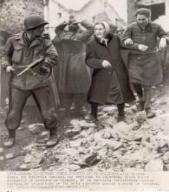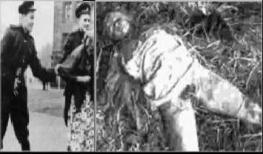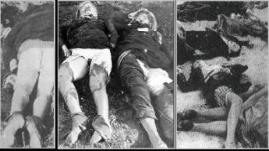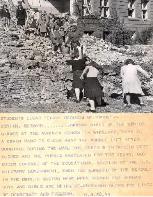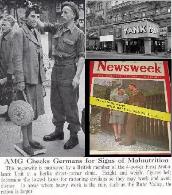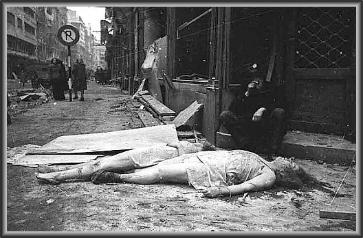| London's International News Service reported in January of 1946 that American soldiers' wives who were brought to Germany were given special authorization to wear military uniforms because "the GIs did not want their wives mistaken for Frauleins by other troops" and thus molested, raped or propositioned. In the first six months of American occupation, venereal disease jumped to twenty times its former level. The New York World Telegram, January 21, 1945, stated: "Americans look on the German women as loot, just like cameras and Lugers." So did others. When Stuttgart was first occupied by the French immediately after the war in August 1945, mostly French colonial soldiers from Morocco, Algeria and Tunisia under French command rampaged through the bombed out city and shelters and committed an orgy of rape. The local police verified 1,198 cases of rape. The ages of the victims ranged from 14 to 74. According to police reports, most of them were attacked in their homes by turbaned thugs who broke down the doors in looting forays. Four of the women were killed by their attackers, and four others committed suicide. One of the victims was killed by her husband who then killed himself. They committed 385 rapes in the Constance area, 600 in Bruchsal and 500 in Freudenstadt. They moved in gangs relentlessly from home to home in Karlsruhe, threatening, raping and stealing all they could carry. In the County Women's Clinic in Karlsruhe alone, 276 terminations of pregnancies after rape were performed in April and May of 1945. Eisenhower, fearing bad publicity, then ordered Stuttgart under American occupation, but when the story broke anyway, American newspapers immediately and without any investigation, discounted it as "German propaganda," apparently forgetting that the war was over. Although not technically rape, since American occupation troops had ready access to food needed by hungry, deprived German and Austrian women, often to feed their children with, sexual favors were sold out of desperation. By the end of 1945, the official ration in the U.S. zone of Germany had slid to 1550 calories per day, and it later fell even lower to 1275 calories by the spring of 1946. In some areas, people were not receiving rations of much more than 700 calories per day, allotments well below the minimum necessary to maintain health. On December 5, 1945, the Times reported: "the American provost marshal Lieutenant Colonel Gerald F. Beane said that rape presents no problem for the military police because a bit of food, a bar of chocolate, or a bar of soap seem to make rape unnecessary. Think that over, if you want to understand the situation in Germany." But rape WAS a problem. By April 1945, 500 rape cases per week were being reported to the Judge Advocate General of American forces in Europe and those were only the reported rapes in limited areas. According to recently disclosed US military records, between 1942 and 1945, US GIs were legally "charged with" committing 11,040 rapes in Germany (a far lesser number were prosecuted). G.I.s were warned against indiscriminate sex but merely to protect themselves from disease, not to face prosecution for rape or prevent pregnancies. TIME magazine reported in September, 1945 that the government provided American soldiers with 50 million condoms per month... at the same time German women could be arrested for fraternizing with US soldiers! German and Austrian courts had no jurisdiction over paternity cases involving Americans, and during the early stages of the occupation, the U.S. Army would not allow an American to make support payments to a German or Austrian woman even if he admitted being the father of their child because such allotments were considered "aid to the enemy". Neither would the U.S. military take any responsibility for illegitimate children fathered by its occupation troops, nor would it permit marriages between American troops and Austrian women until January 1946, and between American troops and German women until December 1946. But the U.S. Military certainly made it easy for irresponsible G.I.s to have casual sex with German girls. Aside from providing free condoms, on April 8, 1946, The Stars and Stripes published an article titled "Pregnant Frauleins Are Warned!" explaining that the U.S. Army was not responsible for the sexual relationships of its personnel and: "Girls who are expecting a child fathered by an American soldier will be provided with no assistance by the American Army ... If the soldier denies paternity, no further action will be undertaken other than to merely inform the woman of this fact. She is to be advised to seek help from a German or Austrian welfare organization. If the soldier is already in the United States, his address in not to be communicated to the woman in question. Claims for child support from unmarried German and Austrian mothers will not be recognized." Meanwhile, in Austria, the Soviets in Vienna were not only raping but also starving their victims to death. Women under Communist occupation ate less than 1,000 calories a day, and 1,000 new cases of TB suddenly arose each month. Pregnant women, the elderly and children were at grave risk. In July of 1945 alone, 389 out of 1,000 newborns, most "rape babies", were dying. In Salzburg, under the Americans, there was at first a strict anti-fraternization policy with the local population. The first Americans arriving in Salzburg from the west were units which had been issued a 'Handbook for Germany', which prescribed a typically "strict" treatment of the locals. The zone of occupation controlled by the US Armed Forces consisted of the provinces of Salzburg and Upper Austria, south of the Danube River, and parts of the Austrian capital, Vienna. The number of GIs stationed there between 1945 and 1955 eventually reached several hundred thousands. The US occupation of Austria lasted for ten years and produced almost 2,000 illegitimate children between 1945 and 1955 in the province of Salzburg alone. During these first years as occupiers, 80% of children in Austrian suffered from malnutrition, and the population was understandably depressed. By estimates, 94,000 "Besatzungskinder" or 'occupation children' were born in the American zone fathered by American soldiers in the decade after 1945, most of whom ended up as wards of the German and Austrian welfare services. More recent estimates revise this figure downward to around 36,000-38,000 children born to an American parent (as well as 10,188 to French, 8,397 to British, 1,767 to Belgians, 6,829 to unknown nationalities, and untold thousands to Soviets). Most never met their fathers and many of these children were never adopted and remained in long-term public care The enemy Germans had been so thoroughly dehumanized that depravity and abuse by the victors was accepted. Civilians had born the brunt of the murderous Allied air war without any moral outrage emanating from the civilized world. Secondly, the Allies had agreed to and helped plan the genocidal expulsion of millions of people from their homes in the east, and this too passed without disapproval. Likewise, few objected as women and children suffered immensely from starvation policies put into place after war's end by Soviets and Allies alike. The last item on the agenda for the unprotected, civilian female non-combatants and their children was the infliction of "re-education" policies to forever "break the German will to wage war". What were these women doing during this time? Germany was missing 15 million men. Husbands, brothers and sons were killed, maimed or not yet released from their long captivity, and the clean up was left to the women, many in grief, illness and physical distress. The women also had to feed and house their children and elderly parents. They also tended the wounded, buried the dead and salvaged belongings. Many women still had to stand in line for hours to get bread or butter and ended up with nothing. It was a daily battle for survival. With the lack of manpower to clear the rubble, women were left to rebuild Germany in the postwar period. To make sure that they did, the Allied Control Council introduced a MANDATORY work duty for women and, rather than refer to them as slave laborers, they gave the women in charge of debris removal the generic name of "rubble women" and usually allowed them a few added food rations as a token reward. The western media likes to talk about "rubble women" as if it was a cheerful and voluntary work detail. In reality, some females cleaning up the destroyed cities had no choice: many were much too old, too young or too malnourished to do hard manual labor and quickly became ill or perished as a result. Women on work crews often worked under armed guards, often with no private sanitation facilities. Some were victims of rapes and other criminal activity. Trümmerfrauen was their official name, or "aid workers in the construction industry". With great physical and psychological pain, and using only basic tools and, above all, their bare hands, they loaded rocks with shovels on debris-laden trolleys on rails which they often had to push themselves. Allied bombing had transformed most German cities to nothing more than an estimated 400 million cubic meters of debris. In Berlin alone there were approximately 60,000 women debris removers. Many women volunteered for debris removal out of desperation for higher food rations. The food ration cards had five categories and those who physically worked hardest got the highest rations. Housewives, on the other hand, were classified in the same category as deskbound workers. Long lines of women worked on the piles of rubble, and watching them hammering out stones and handing them down in buckets was a common sight, even years after the war ended. When the men began returning home from the war, they faced women who had become very independent and had established a different role in society. At the end of the 1940s, when more and more men returned home from their captivity, divorce rates increased at a rate Germany had never experienced. Most despicably of all, many women were forced to watch staged atrocity exhibits involving human corpses and at times were even forced to bury dead bodies without protection, thus heartlessly exposed to disease (see link above). Thousands of German civilians, mainly women, were forced to watch film such as "Mills of Death" ('Todesmühlen') fabricated by the "re-education" team and screened at hundreds of cinemas, some hastily rebuilt from bombed out ruins while hospitals and schools remain in rubble, for the sole purpose of imbuing the Germans with a sense of collective guilt and indoctrinating them in "American" values. In these films, grisly scenes from work camps were recreated into dramatic Hollywood-type movies to shame German women who were, at the same time, deprived of the human right to grieve their own dead and trying to come to grips with their own personal tragedies and the horrors of war. |
| Ilya Ehrenburg's vicious propaganda machine had widely disseminated false reports of Nazi rape in Russia to ensure that the Red Army stormed into Germany with no pity. It worked. They committed the largest mass rape in history, with the girls and women of East Prussia bearing the first brunt of their brutality. Here, most females were gang raped and then murdered. "Tot den Deutschen Okkupaten!" (Death to the German Occupants) the victorious Soviet soldier cried, and regardless of age, German women and girls were taken without mercy. Thousands of women shuddered as the words "Frau komm!" grunted from the invading army, for it not only meant they were about to be violated, it might also mean torture or death of themselves, their mothers, grandmothers or daughters. Alexander Solzhenitsyn was a young captain in the Red Army when it entered East Prussia in 1945. He wrote later in his book, 'The Gulag Archipelago': "All of us knew very well that if girls were German they could be raped and then shot. This was almost a combat distinction." He was arrested and sentenced to eight years in a labor camp. Other Russian officers agreed with him and those who dared to report excesses of violence against civilians met a similar fate. Scenes of sexual depravity and horror spread throughout the Eastern regions as rampantly as the diseases the criminals left behind. In Silesia, Red Army soldiers embarked upon another horrendous spree of rape so brutal that in one instance in Neisse, 182 Catholic nuns were raped by Red Army soldiers and in the diocese of Kattowitz, the soldiers left behind 66 pregnant nuns. In all German areas taken by the communists, civilians who were not exiled were subjected to brutality. Master hate propagandist Ilya Ehrenburg told soldiers on January 31, 1945: "The Germans have been punished in Oppeln, in Königsberg and in Breslau. They have been punished, but yet not enough! Some have been punished, but not yet all of them." In contrast to Ehrenberg's rhetoric, rape was in truth a German military offense punishable by death. Rape by German troops was the smallest recorded in occupied territories and lower than that of US troops on US bases. As the Red Army started its offensive toward Berlin during the spring of 1945, thousands of Germans from the east tried to cross the Oder River and flee westward, but there were too many, and many were trapped as they waited to be allowed to cross. As many as 20,000 girls and young women were stranded and at the mercy of the Red Army as they marched through in February. Many were captured, lined up, with some singled out for immediate "pleasure", then packed into trains headed for Siberia in April, 1945, some repeatedly raped while being transported and others dying along the way from lack of food and mistreatment. Once in Siberia, they were slave laborers forced to do heavy manual labor such road building, all the while enduring constant sexual abuse. Many of these women remained in Stalin's work camps for up to five years, during which time two- thirds of them died. Some were sent to an infamous camp near Petrozavodsk in Karelia called Number 517. Once they arrived, they were paraded naked in front of the camp officials who would select favorites, promising lighter work in exchange for sex. "Stubborn prisoners" were subjected to solitary confinement, genital mutilation or murder. Of the 1,000 girls and women who were sent to that camp, over half, or 522 of them, died horrible deaths within six months.* * In 1949, some surviving women, suffering from illness and severe emotional trauma, were transported back to eastern Germany but forbidden to talk about their experiences. Others waited 10 years for freedom. Once the Iron Curtain fell in 1989, some of former labor camp prisoners related their experiences only to find it was politically incorrect to "dwell" on such topics in modern Germany. The Red Army entered Berlin first, seething with hatred and determined to exact vengeance, while the Americans and the British lagged behind to the west. They had two months to freely plunder and rape, and Berlin was a city virtually without men. The female population had swelled to 2,000,000 with thousands more refugee women who had fled there from the east. Up to a million females from ages 8 to 80 were believed to have been raped. Over 10,000 women and girls are recorded as having died as a result. There were so many rapes that doctors in the hospitals could not even treat them all. On one occasion, when Stalin was told that Red Army soldiers sexually maltreated German refugees, he said: 'We lecture our soldiers too much; let them have their initiative.' In fact, Stalin's police chief Lavrenti Beria was a serial rapist himself and he condoned rape as an instrument of state military policy. Beria's bodyguard, Russian actress Tatiana Okunevskaya, and an American diplomat all witnessed Beria grabbing German women off the street and shoving them into his limousine for his warped pleasure. It is claimed that this man who ran the NKVD, the feared forerunner to the KGB, drugged and raped more than 100 school-aged girls and young women. In one notorious instance, Red Army soldiers entered the maternity hospital at Haus Dehlem and raped pregnant women, women who had just given birth, and women in the process of giving birth. The future Pope Paul VI. lamented that in Berlin even nuns in habit were raped. Some women lived for weeks on rooftops trying escape violence. Thousands committed suicide as a result of sexual abuse, thousands of underage girls died as a result of violent injury and thousands of girls left pregnant would be left to virtually starve as the Allies blocked shipments of food from Berlin. Heinz Voigtländer, a consulting surgeon at the hospital in Ludwigslust, said: "It was particularly dreadful ... with the pregnancies that dated from the first half of 1945.... I remember a figure of 150 to 180 abortions that we had to carry out at that time. Frequently this was a matter of pregnancies in the fourth, fifth and even in the sixth month....Sometimes, in the seventh or eighth month, this help no longer was possible. Then the nurses promised to look after the child after the birth. But once we observed that a woman left the hospital after the birth and drowned her child in the brook that flowed right by the hospital. We spoke as little as possible about these matters.” As well as the astonishing estimate of well over a million Red Army rapes in Germany, there were between 70,000 and 100,000 in Vienna, anywhere from 50,000 to 200,000 in Hungary, as well as thousands in Romania and Bulgaria, which had been pro-NS. “In Berlin, in August 1945, out of 2,866 children born, 1148 died, and it was summer, and the food more plentiful than now. From Vienna, a reliable source reports that infant mortality is approaching 100 per cent." US correspondent Dorothy Thompson Rape was not the only violent abuse German women suffered. Throughout the regions of Germany given to the communists, women were treated with barbaric cruelty, and their suffering did not end in 1945.Those who could not or would not relinquish their homes to their new masters were persecuted. To the surprise and horror of the trapped inhabitants, occupying Americans in war torn east Germany proper "liberated" it just long enough to turn it all over to the Red Army for enslavement. In this area, the communist GDR, for stated reasons of " public security", instituted detention areas for political prisoners, many of them female. From 1950 to 1989, an insidious internal spy agency existed with a military structure and over 90,000 workers. There were district offices in over 30 cities. Not spoken of in our media, thousands of women suffered horrible repression at the hands of the Communists. With no men left to protect the women, the 'Stasi' in East Germany stuffed unruly females behind the walls of dank, dark, 13th century Hoheneck castle in Thuringia. The photo below, far right, was smuggled out of Danzig by US news sources and shows a public hanging of 11 "war criminals" consisting of 10 Germans, four of whom were women. A crowd of 35,000 watched as the cars the victims had been forced to stand on drove away, leaving them dangling from the ropes. These events took place in all communist occupied formerly German areas. |
| Photos above, from left: A woman being "examined" with no privacy on a street corner in Berlin by a male British soldier; A June, 1947 Newsweek magazine cover about GIs sowing "wild oats". A G.I. "round up" of old women. A "chain gang" of young school girls were obviously not prepared or dressed for such a work detail. It was intended as a brain washing device (see description). |
| The Human Problem: The High Cost of War Paid by German Women |
| "Kill!Kill! In the German race there is nothing but evil. Stamp out the fascist beast once and for all in its lair! Use force and break the racial pride of these German women. Take them as your lawful booty. Kill! As you storm forward. Kill! You gallant soldiers of the Red army." Ilya Ehrenburg |
| The "Civalrous" Allies |
| click |
